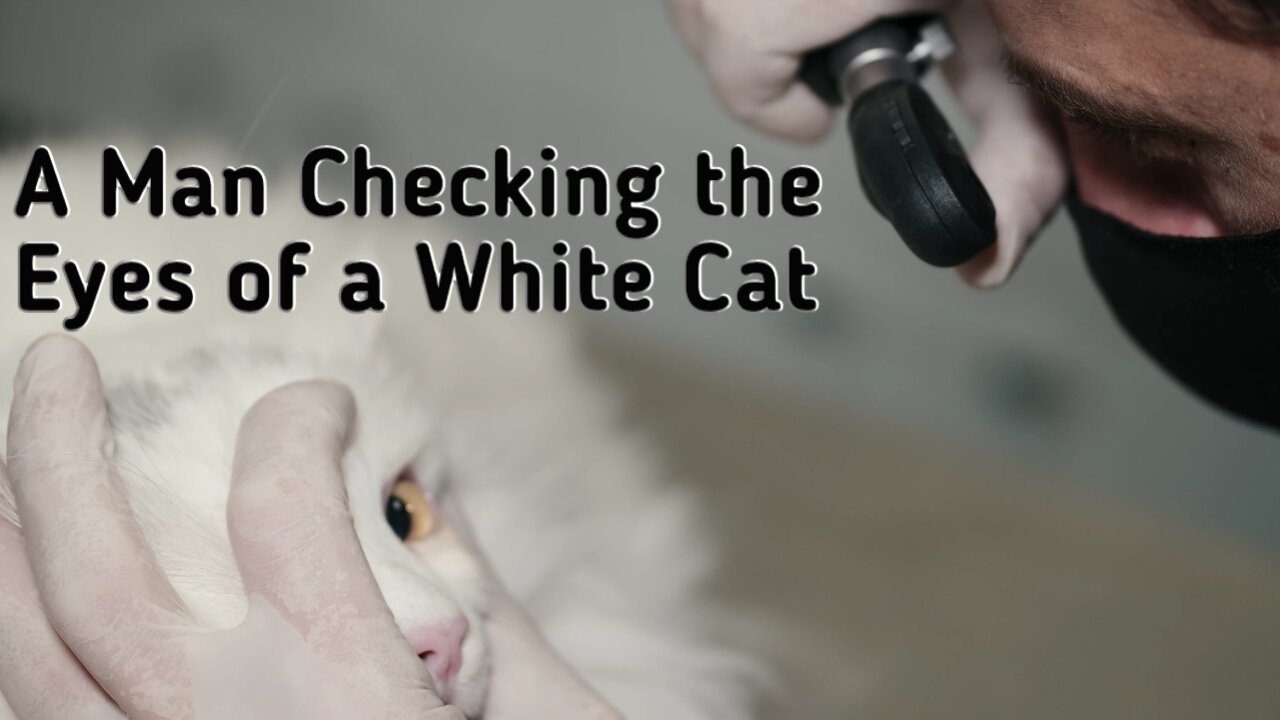Premium Only Content

A Man Checking the Eyes of a White Cat
A Man Checking the Eyes of a White Cat
There are many breeds that include a white cat, from the British Shorthair and Sphynx to the Turkish Van. While many pet parents want to claim their cat falls into the rare, colorless category, a true white cat is defined by the lack of melanin pigmentation – the gene that gives her coat and eyes color.
As little as 5% of the total, general cat population can be called a truly white breed of cat but for most white cat lovers, definitions pale in comparison to their kitty’s amazing personalities, distinct features, and quirky antics.
Your cat’s eyes, usually clear and bright, are looking a little gooey. They might be pawing at them or rubbing their face against the sofa or on the rug. Clearly, something’s wrong.
Anything from a simple cold to a serious illness could be causing your cat’s eye discharge. Learn a few of the more common causes of eye discharge, when to see a vet, and what you can do at home to help your feline friend.
Eye Discharge Causes
A healthy cat’s eyes should be bright and clear.
Eye problems can bring out another cat entirely, one who paws at their eyes, squints, or blinks excessively. Because eye problems can lead to devastating consequences -- including surgery or blindness -- always talk to your vet when you notice your cat has irritated eyes. A few common reasons for cat eye discharge include:
Feline upper respiratory infections. A frequent cause of eye discharge in cats, these can include viruses such as feline calicivirus, a contagious respiratory disease, pneumonitis or rhinotracheitis (herpesvirus), bacteria, and protozoa. Symptoms can be mild or progress to something very serious and may include a sticky, pus-like eye discharge.
Conjunctivitis (pink eye) . An inflammation of the light pink lining around your cat’s eye, conjunctivitis can cause one or both of your cat’s eyes to look red and swollen, be light-sensitive, and have clear, teary or thick mucus eye discharge. Conjunctivitis with fever, diarrhea, and trouble breathing can point to potentially fatal feline infectious peritonitis, though this isn’t very common.
Corneal disorders . A cat’s cornea, the dome-shaped surface that covers the front of the eye, can become inflamed, injured, or ulcerated. The result may be cloudiness, excessive blinking, inflammation, and increased tear production.
Watery, tearing eyes (epiphora) . Blocked tear ducts, an overproduction of tears, allergies, viral conjunctivitis, and more can be behind your cat’s abnormal tearing.
Uveitis. An inflammation of the internal structures of the eye, trauma, cancer, immune problems or infections can cause the serious, often painful inflammation of uveitis.
Dry eye (keratoconjunctivitis sicca) . A chronic lack of tear production, dry eye can lead to an inflamed cornea, red eyes, and if left untreated, blindness. Because the watery portion of tears is missing, a yellow, gooey eye discharge can result.
Other eye discharge causes include allergies, something lodged in the eye, or third eyelid problems.
Eye Discharge Treatments
Because so many conditions can lead to eye discharge in cats, you really need to talk to your veterinarian before trying any eye discharge treatments on your cat.
Depending on what your veterinarian finds, treatment for cat eye discharge might include:
Eye Discharge Treatments
Because so many conditions can lead to eye discharge in cats, you really need to talk to your veterinarian before trying any eye discharge treatments on your cat.
Depending on what your veterinarian finds, treatment for cat eye discharge might include:
Feline upper respiratory infection . Specific treatments depend on the cause of the infection as well as how serious it is and may include eye medications, antibiotic., decongestants, and fluids.
Conjunctivitis . Pollen, dust, weeds, or other irritants can cause conjunctivitis, which may be treated with a steroid ointment. if it's caused by a bacterial infection, antibiotic ointments may be used.
Corneal disorders . Treatment depends on what’s troubling your cat’s cornea, but may include keeping kitty’s eyes clean, antibiotic eye ointment or drops, drops that promote healing, removing loose corneal tissue, cauterization, or surgery.
Watery, tearing eyes . Under general anesthesia, your vet may use plain water or saline to flush your cat’s blocked tear duct. If there's an infection, antibiotic eye ointment or drops may be needed.
Uveitis . The right treatment depends on what’s causing your cat’s uveitis, though that’s often hard to diagnose. Care may include eye ointment or drops to control inflammation and pain.
Feline calicivirus . Secondary bacterial infections, which can cause pneumonia and other serious issues, are common with calicivirus, so always call your vet if you suspect your cat has this disease. Treatment may include symptom control, antibiotics for secondary infections, and supportive care.
Dry eye . Many things can cause dry eye, from immune-mediated disease to distemper. Treatment can include eye drops or ointments, immune-suppressing drugs, antibiotics, or artificial tears.
When to See a Vet
Your cat’s eyes are as delicate as they are beautiful. Small problems can quickly turn into serious conditions. If your cat’s eye discharge symptoms don’t clear up within 24 hours or if your cat is squinting, talk to your veterinarian right away.
If you have medications left over from a previous eye problem, don’t use them on your cat’s eyes. Different eye issues call for different medications, and you can end up causing serious injury by using the wrong one.
Home Care: Tips for Keeping Your Cat’s Eyes Healthy
You can help avoid eye problems in your cat by keeping up with yearly vaccinations, avoiding kitty overcrowding, and checking your cat’s eyes frequently for redness, cloudiness, a change in color or shape, discharge, or sensitivity to light.
To safely remove your cat’s eye discharge and make them more comfortable while waiting for their vet appointment, arm yourself with a bag of cotton balls and these simple tips from the ASPCA:
Dip a cotton ball in water. Wipe away the eye discharge, always from the corner of the eye outward. Use a fresh cotton ball for each eye.
Steer clear of any over-the-counter drops or washes unless your vet has prescribed them.
Because correct treatment can be so critical to the health and well-being of your cat, always talk to a veterinarian to be sure kitty is getting just the right care needed.
-
 LIVE
LIVE
I_Came_With_Fire_Podcast
5 hours agoHalf the Gov. goes MISSING, Trump day 1 Plans, IC finally tells the Truth, Jesus was NOT Palestinian
220 watching -
 4:11:49
4:11:49
Nerdrotic
7 hours ago $2.26 earnedThe Best and Worst of 2024! Sony Blames Fans | Batman DELAYED | Nosferatu! |Friday Night Tights 334
106K27 -
 7:55:51
7:55:51
Dr Disrespect
11 hours ago🔴LIVE - DR DISRESPECT - WARZONE - SHOTTY BOYS ATTACK
181K26 -
 1:30:23
1:30:23
Twins Pod
10 hours agoHe Went From MARCHING With BLM To Shaking Hands With TRUMP! | Twins Pod - Episode 45 - Amir Odom
104K24 -
 1:02:30
1:02:30
Exploring With Nug
12 hours ago $0.33 earned2 Duck Hunters Missing After Kayak Capsizes!
37.7K2 -
 46:48
46:48
Mally_Mouse
5 hours agoLet's Hang!! -- Opening Christmas gifts from YOU!
51.5K -
 44:55
44:55
Athlete & Artist Show
20 days ago $1.84 earnedNHL 4 Nations Snubs, Was Hawk Tuah Coin A Scam?
53.5K -
 33:47
33:47
Stephen Gardner
11 hours ago🔥Pentagon Whistleblower UNLEASHES on Biden and Obama!
108K172 -
 2:20:30
2:20:30
The Dilley Show
12 hours ago $3.75 earnedRoger Stone in Studio plus Q&A Friday! w/Author Brenden Dilley 12/27/2024
90.4K20 -
 1:57:02
1:57:02
The Charlie Kirk Show
10 hours agoThe Great H-1B Battle + AMA | Lomez | 12.27.24
174K235